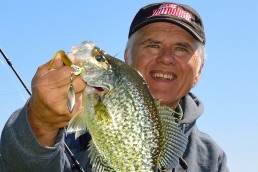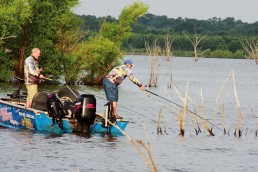Basic Finger Jigging
SHARE THIS POST
There are many questions about “finger jigging” that are sent in. The most asked regard the “how” and “why” I developed the technique. In a way, these two questions can be answered at the same time. Once I was using lightweight, 2-inch Power Minnows with B-Fish-N 1/16- and 3/32-ounce Precision jig heads. At first, it was with monofilament line on a spinning reel, and the results were a lot of tangles. Then I switched to 10- and 15-pound-test Gorilla Braid, which had a low diameter, plenty of strength and less tangles. However, there was still a lot of loose wound line on the spool.
So the question that came in was, “How can I keep the line tighter?”
First, I’d retrieve the line by holding it with the hand on the rod between my index and middle fingers. This worked somewhat, but was a bit awkward to say the least. Then for some reason I extended my index finger and it worked fairly well. At that point I could see the rod tip jump at different rhythms as I would vary the speed or stiffen/relax my finger to adjust the amount of pressure pushing on the line as it hit on each revolution of the spool. With that observation, plus the fact that fish started hitting consistently, I developed “finger jigging.”

The next question coming in has been regarding the rod, reel and line. People know it takes an open-facing spinning rig, but want to know if ultra-light, medium or heavy action is best, the length of rod, pound test of line, etc., that is preferred by me. Actually, any spinning rig will work, but the best is with a reel that uses lighter, lower-diameter line, a rod that will cast light lures with a flexible tip and line with flexibility and less line twist. My favorite reel is a Pflueger Supreme ultra-light spooled with 6-, 8- or 10-pound-test low-vis. Green Nanofil line, with 8 being the primary use. As for the rod, I’d really like to work with a company to develop a line that would work perfectly, but haven’t found one interested, yet. So, I’ve stayed with the Shakespeare Agility line and mainly use the 7-foot ultra-light model, but I’ve had some luck with the medium model for a little heavier lead head.
Of course everyone wants to know what lures are best. But a main question often is about the very basic “kit,” and what I’ve started using. Actually, I’ve answered part of that above with the 2-inch Power Minnow, and almost any lure jigged can be used with “finger jigging.” But for now let’s concentrate on the “basic kit.” For soft plastic lures use 2- and 3-inch Power Minnows, a 3-inch Power Twitch Tail Minnow and a 4-inch Natural Forage Baits Lil Killer, with all in some type of baitfish color. The best jig heads I’ve found to be are the B-Fish-N Precision in all sizes up to 3/16 ounce for most baits and Berkley Round Heads in 1/16, 1/8 and 1/4 ounce for the thicker-bodied lures when a larger hook is needed.
To this kit I’ve added one model to jig heads with the Blakemore Casey’s Runner for the Twitch Tail Minnow and Lil Killer. This brings in the added attraction of a spinner blade when needed for that little extra “something.”
Are you enjoying this post?
You can be among the first to get the latest info on where to go, what to use and how to use it!
This is my basic kit, but anything with a whippy tail, such as a 4-inch finesse worm, can be added. I’ve even done this with swimbaits, and it’s been excellent when used with a Blitz Spyder Finesse Jig, especially in their White, and a 3-inch Power Minnow body. In fact, I’ve had good luck using the Finesse Jig with a twin-tail trailer of some sort like the old Auger Frog and running it along areas with the technique where spinnerbaits are the norm.
I’ll also add Kick’n Bass Attractant to the kit. My preferences in scents are Java, Crappie and Anise Shad. This is the perfect add-on for the technique of making several casts through an area to develop an “odor zone” that will stir fish into striking.
I’m sure everyone who has read my articles or seen the videos knows how to finger-jig, but as a quick refresher and for those who don’t know, here it is: Extend the index finger of the rod hand and let it hit the line as it rotates. The faster the retrieve, the quicker the jigging motion; the slower the retrieve, the more pronounced the jigging motion is with a harder jump. If you stiffen the finger for a harder hit, the jig will jump more, while a lighter hit on the relaxed finger will give the jig a quick light bounce. Experimenting with the different positions of the index finger is the only way to learn. But be warned—it can become tiring on the finger and rod hand with occasional cramps occurring, especially for begninners. But overall, it is an easy, productive technique that anyone that can use for an open-facing spinning rig.
You can travel very light if you just go finger jigging. It is also a great shoreline technique, especially for smaller lakes and ponds where a lot of distance can be covered without a lot of tackle.
I hope I’ve been able to answer everyone’s questions on the how, why and what for the basics of finger jigging. If there are more quesitons, contact me and I’ll be glad to answer even more on this technique.
MWO
SHARE THIS POST
Did you enjoy this post?
You can be among the first to get the latest info on where to go, what to use and how to use it!
Dan Galusha
Dan Galusha has fished all of his life, worked more than 45 years in the outdoor/media industry, and was inducted into the Fresh Water Fishing Hall of Fame as a Legendary Communicator. Direct questions through dansfishntales.com, facebook.com/dansfishntales and facebook.com/shootnplink.



